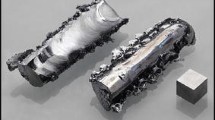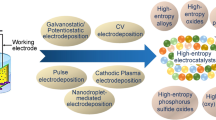Abstract
The process of electrooxidation of a lead-rhodium binary deposit on a graphite electrode has been studied. The anodic voltammetric curves show the peak of electrooxidation of lead (− 0.52 V), the peak of electrooxidation of hydrogen sorbed on the rhodium (+ 0.2 V), and additional peaks at potentials − 0.42 and − 0.30 V, the nature of which has been investigated. Using the theory of regular solutions, the changes in the equilibrium potentials of lead in lead-rhodium alloys in comparison with the equilibrium potential of lead were calculated. The data obtained showed that the anodic peak at potential − 0.42 V can be due to the selective electrooxidation of lead from the Pb4Rh intermetallic compound (IMC), and the peak at potential − 0.30 V can be due to the selective electrooxidation of lead from the Pb2Rh IMC. The presence of a stable phase structure is confirmed by data obtained by examining the surface of a graphite electrode with a binary lead-rhodium deposit using scanning electron microscopy (SEM). For analytical purposes, it is convenient to use the peak of selective lead electrooxidation from the intermetallic Pb2Rh compound observed on the voltammetric curve at potential − 0.30 V. The current of this peak is proportional to the concentration of rhodium(III) ions in the solution.







Similar content being viewed by others
References
Bollella P, Fusco G, Tortolini C, Sanzò G, Favero G, Gorton L, Antiochia R (2017) Beyond graphene: electrochemical sensors and biosensors for biomarkers detection. A review. Biosens Bioelectron 89(Pt 1):152–166. https://doi.org/10.1016/j.bios.2016.03.068
Akanda MR, Sohail M, Aziz MA, Kawde AN (2016) Recent advances in nanomaterial-modified pencil graphite electrodes for electroanalysis. A review. Electroanalysis 28(3):408–424. https://doi.org/10.1002/elan.201500374
Brownson DAC, Foster CW, Banks CE (2012) The electrochemical performance of graphene modified electrodes: an analytical perspective. Analyst 137(8):1815–1823. https://doi.org/10.1039/c2an16279b
Stozhko NY, Kozitsina AN, Chiavarini S, Cremisini C, Ubaldi C (2007) Determination of trace metals and pesticides in must during fermentation in a vinification process. A review. Ital J Food Sci 19(1):25–38
Shen H, Mark JE, Seliskar CJ, Mark HB Jr, Heineman WR (1997) Stripping voltammetry of copper and lead using gold electrodes modified with self-assembled monolayers. J. Solid State Electrochem 1(3):241–247. https://doi.org/10.1007/s100080050055
Salmanipour A, Taher MA (2011) An electrochemical sensor for stripping analysis of Pb (II) based on multiwalled carbon nanotube functionalized with 5-Br-PADAP. J Solid State Electrochem 15(11-12):2695–2702. https://doi.org/10.1007/s10008-010-1197-3
Intarakamhang S, Schuhmann W, Schulte A (2013) Robotic heavy metal anodic stripping voltammetry: ease and efficacy for trace lead and cadmium electroanalysis. J Solid State Electrochem 17(6):1535–1542. https://doi.org/10.1007/s10008-013-2018-2
Streltsov EA (2011) Electrochemical deposition of thin films and nanostructures of semiconductor metal chalcogenides. Bull Belarusian State Uni 3(2):15–19
Silwana B, Van der Horst C, Iwuoha E, Somerset V (2014) Screen-printed carbon electrodes modified with a bismuth film for stripping voltammetric analysis of platinum group metals in environmental samples. Electrochim Acta 128:119–127. https://doi.org/10.1016/j.electacta.2013.11.045
Van Der Horst C, Silwana B, Iwuoha E, Somerset V (2015) Bismuth-silver bimetallic nanosensor application for the voltammetric analysis of dust and soil samples. J Electroanal Chem 752:1–11. https://doi.org/10.1016/j.jelechem.2015.06.001
Kolpakova NA, Borisova NV, Nevostruev VA (2001) Nature of a positive anodic peak in the stripping voltammogram of binary platinum-metal systems. J Anal Chem 56(8):744–747. https://doi.org/10.1023/A:1016789711858
Marchakov IK (2002) Anodic dissolution and selective corrosion of alloys. Prot Met 38(2):118–123. https://doi.org/10.1023/A:1014908930959
Zartsyn ID, Vednskij AV, Marshakov IK (1991) On transformation of a noble component of a selectively dissolving homogeneous alloy in active state. Zashch Met 1:3–12
Gamburg YD (2016) Development of the electrocrystallization theory. Russ J Electrochem 52(9):832–846. https://doi.org/10.1134/S1023193516090032
Wagner C (1952) Thermodynamics of alloys. Addison-Wesley Press, Mass
Gamburg YD (1997) Electrochemical crystallization of metals and alloys. Janus-K, Moscow
Kozin LF, Nigmetova RS, Dergacheva MB (1977) Thermodynamics of binary amalgam systems. Science, Moskow
Łukaszewski M, Hubkowska K, Koss U, Czerwiński A (2013) On the nature of voltammetric signals originating from hydrogen electrosorption into palladium-noble metal alloys. Materials 6(10):4817–4835. https://doi.org/10.3390/ma6104817
Montero MA, Fernández JL, Gennero De Chialvo MR, Chialvo AC (2014) Characterization and kinetic study of a nanostructured rhodium electrode for the hydrogen oxidation reaction. J Power Sources 254:218–223. https://doi.org/10.1016/j.jpowsour.2013.12.095
Montero MA, Gennero De Chialvo MR, Chialvo AC (2015) Kinetics of the hydrogen oxidation reaction on nanostructured rhodium electrodes in alkaline solution. J Power Sources 283:181–186. https://doi.org/10.1016/j.jpowsour.2015.02.133
Kondrashin VY, Marshakov IK (2000) Physicochemical basis of uniform, pseudoselective, and selective dissolution of homogeneous alloys. Prot Met 36(5):438–444. https://doi.org/10.1007/BF02764088
Kondrashin VY, Marshakov IK (1997) Threshold phenomena intrinsic to anodic dissolution of intermetallic phases. Russ J Electrochem 33(9):939–944
Gorchakov E, Ustinova E, Kolpakova N (2012) Anodic stripping determination of Pt(IV) based on the anodic oxidation of Hg and Cd from electrochemically deposited Hg-Pt and Hg-Cd alloy phases. J Solid State Electrochem 16(7):2425–2428. https://doi.org/10.1007/s10008-012-1709-4
McLean D (1957) Grain boundaries in metals. Clarendon Press, Oxford
Blakely JM, Shelton JC (eds) (1975) Equilibrium adsorption and segregation. Academic Press, New York, Surface Physics of Materials
Williams FL, Nason D (1974) Binary alloy surface compositions from bulk alloy thermodynamic data. Surf Sci 45(2):377–408. https://doi.org/10.1016/0039-6028(74)90177-0
El-Boragy M, Jain KT, Mayer HW, Schubert K (1972) Z Metallkd 63(11):751–753
Mayer HW, Schubert K (1973) Kristallstruktur von Rh4Pb5. J Less-Common Met 33(1):91–98. https://doi.org/10.1016/0022-5088(73)90059-3
Kaplin AA, Klimachev GV, Slepchenko GB (1987) J Anal Chem 42(10):1812–1816
Klimachev GV, Slepchenko GB (1992) Russ J Electrochem 44(6):119–125
Sukhotin AM (1981) Reference book on electrochemistry. Chemistry, Moskow
Andreev YA (2016) Electrochemistry of metals and alloys. Higher Education and Science, Moskow
Kondratiev VN (ed) (1974) The energy of rupture of chemical bonds. Potentials of ionization and electron affinity. Science, Moskow
Bokris J, Komuel B (1971) Modern problems of electrochemistry. Mir, Moskow
Lesnik AG (1962) Models of interatomic interaction in the statistical theory of alloys. Fizmatgiz, Moskow
Pauling L, Pauling P (1975) Chemistry. W.H. Freeman, San Francisco
Kolpakova NA, Nesterov AA (2014) Assessment of phase composition of electrolytic deposits by stripping voltammetry. Procedia Chem 10:92–96. https://doi.org/10.1016/j.proche.2014.10.017
Acknowledgements
The research is carried out at Tomsk Polytechnic University within the framework of Tomsk Polytechnic University Competitiveness Enhancement Program grant (VIU-TOVPM-316/2017). The authors are grateful to the director of the Innovation Center “Gold and Platinum” A.Ya. Pshenichkin, Ph.D., and Rudmin M.A., Ph.D., for the provision of scientific equipment, assistance, and support.
Author information
Authors and Affiliations
Corresponding author
Rights and permissions
About this article
Cite this article
Kolpakova, N.A., Oskina, Y.A. & Sabitova, Z.K. Determination of Rh(III) by stripping voltammetry on a graphite electrode modified with lead. J Solid State Electrochem 22, 1933–1939 (2018). https://doi.org/10.1007/s10008-018-3898-y
Received:
Revised:
Accepted:
Published:
Issue Date:
DOI: https://doi.org/10.1007/s10008-018-3898-y




